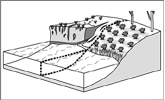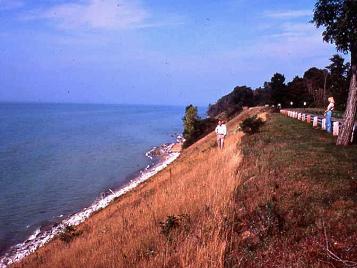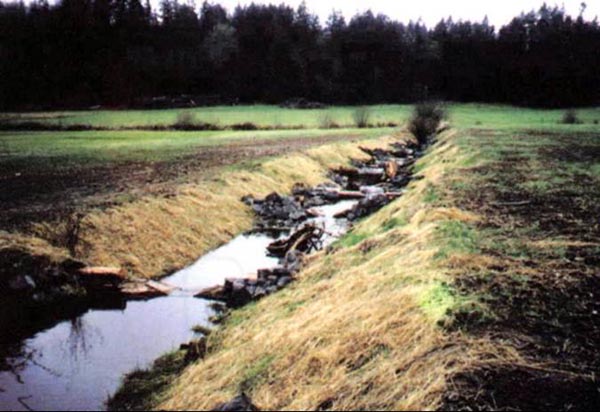| SLOPE FLATTENING |
 |
1. CATEGORY
4.0 – Slope Stabilization
2. DESIGN STATUS
Level II
3. ALSO KNOWN AS
Slope lay back, bank reshaping, and profile adjustment.
4. DESCRIPTION
Flattening or bank reshaping stabilizes an eroding streambank by reducing its slope angle or gradient. Slope flattening is usually done in conjunction with other bank protection treatments, including installation of toe protection, placement of bank armor, re-vegetation or erosion control, and/or installation of drainage measures (see Figure 1).

Figure 1. Streambank graded back to stable 2:1 angle, protected by rock toe,
and covered with an erosion control blanket.
Manistee shipping channel, Michigan.
Flattening or gradient reduction can be accomplished in several ways:
1. By removal of material near the crest,
2. By adding soil or fill at the bottom, or
3. By placing a toe structure at the bottom and adding a sloping fill behind it.
Right-of-way constraints or space restrictions may limit or preclude the first two alternatives because both entail either moving the crest back (option #1) or extending the toe forward (option #2). The latter option is normally precluded in the case of streambanks. The use of a retaining structure at the base (option #3 - see Live Cribwalls, Vegetated Mechanically Stabilized Earth or Vegetated Gabion Baskets) provides a means of establishing a reduced or flattened slope above the structure.
5. PURPOSE
Slope angle or inclination is one of the principal determinants of stability (Huang, 1983; Hutchinson, 1978). The steeper the slope, the more susceptible it is to both surficial erosion and mass failure. Slope flattening or re-grading is generally one of the first options to consider (Abramson et. al., 1996) as a possible remedial treatment; on the other hand, it will only provide temporary protection unless toe erosion (scour) and channel degradation are arrested and controlled as well. Most soils are stable at a slope gradient of 1V:2H or 1V:2.5H. This is also the maximum gradient for successful conventional planting or re-vegetation, at least in the absence of special soil bio-engineering techniques such as live brushlayering, live fascines, or a live slope grating. Hard bank armor, e.g., rock riprap, should not be placed on slopes steeper than 1V:1.5H. Stable artificial or fill slopes can be constructed as steep as 1V:1H (or even higher) by layering geogrid or geotextile reinforcements between successive lifts of soil (see Technique: Vegetated Mechanically Stabilized Earth). Slope flattening should not be used in highly erosive soils (e.g., loess) or soil conditions (e.g., permafrost) where laying a slope back would subject the slope to erosive influences (direct rain drop impact) or expose the slope to melting (thawing) by the sun's rays.
6. PLANNING
Useful for Erosion Processes:
Toe erosion with upper bank failure Scour of middle and upper banks by currents Local scour Erosion of local lenses or layers of noncohesive sediment Erosion by overbank runoff General bed degradation Headcutting Piping Erosion by navigation waves Erosion by wind waves Erosion by ice and debris gouging General bank instability or susceptibility to mass slope failure
Spatial Application:
Instream Toe Midbank Top of Bank
Hydrologic / Geomorphic Setting
Resistive Redirective Continuous Discontinuous Outer Bend Inner Bend Incision Lateral Migration Aggradation Conditions Where Practice Applies:
Slope flattening should generally be considered whenever possible either by extending the toe, pulling back the crest, or elevating the toe and filling behind a protective toe structure. Possible constraints or prohibitions on the first two options would preclude these approaches to slope flattening. In the case of streambanks, slope flattening also requires consideration of toe armor or protection as well.Complexity:
Low. Slope flattening per se is a relatively simple procedure that entails only re-contouring or profile adjustment. This can be accomplished with an excavator or other earth moving equipment, e.g., dragline.
Design Guidelines / Typical Drawings:
Designs associated with bank reshaping are site dependent and rarely entail flattening alone. Before attempting to re-grade or change a slope profile it is important to determine the cause of instability and to ascertain whether re-grading is an appropriate solution or mitigation measure. The slope gradient should be decreased to an angle that yields a stable slope or safety factor against mass slope failure of at least 1.2 to 1.5, depending upon how critical the site is, uncertainty about soil and site parameters, and the consequence of a slope failure at any given location. Most stable embankment slopes and dams are constructed with either 1V:2H or 1V:2.5H side slopes. Some clayey or silty soils may require flattening to 1V:2H. The type of restoration measure used on the slope also depends on gradient. Purely vegetative treatments require relatively flat slopes (1V:3H or less). Soil bioengineering treatments work best in general on slopes 1V:2H or less, although some methods can be used on slopes as steep as 1V:1H. Limiting slope gradients that take soil and site conditions into account as well as the anticipated treatment method are shown schematically in the Typical Drawing. Additional information and design guidelines for bank reshaping can be found in Washington (2003). Conceptual design drawings for bank re-shaping or flattening are shown in Figure 2.
Figure 2. Conceptual design drawings for bank re-shaping or flattening (from Washington, 2003)Flattening alone may not suffice to achieve mass stability if seepage problems persist. Stability analyses have shown (Gray and Sotir, 1996) that the critical (failure) slope angle of primarily cohesionless slopes subjected to either sudden drawdown or saturated seepage parallel to the slope face is only half that of the same slope in a dry (or moist) condition. In this case, it would also be important to implement internal bank-drainage techniques as well. A flattened or reconstructed slope should be protected immediately against surficial erosion with a re-vegetative treatment and/or rolled erosion control product (e.g., ECB or TRM).
7. ENVIRONMENTAL CONSIDERATIONS / BENEFITS
Environmental benefits of slope flattening accrue primarily from the ability
to establish vegetation more easily on a streambank that is not oversteepened.
A vegetated (or revegetated) bank yields both aquatic and terrestrial environmental
benefits. Streambank vegetation provides cover, shade, and insect food
sources for fish and other aquatic organisms near the water's edge. Upper
and mid bank vegetation provide cover and habitat opportunities for small
mammals and other riparian wildlife. Slope flattening should also result
in easier recreational access to the water's edge from the top of bank and
reduce safety hazards. On the negative side, steep, undercut banks, if stable,
often provide valuable habitats, e.g., for bank swallows; slope regrading,
and flattening may eliminate them.
8. HYDRAULIC LOADING
Additional bank surface created by flattening or re-shaping effectively
creates more roughness in the cross section and dampens the effects of secondary
currents in river bends. The added roughness and cross-sectional area decreases
average and local velocities. A regraded or flattened slope will invariably
require not only some form of protection at the toe to prevent scour erosion,
but face protection as well to prevent both rainfall and stream erosion.
Bare earth normally cannot withstand stream velocities higher than 1 m/sec
(3.3 ft/sec). Fine sandy soils and non-plastic silts are the most vulnerable
to surficial erosion.
9. COMBINATION OPPORTUNITIES
Slope flattening is a prime candidate for combination or integration with
other bank protection treatments. These include structural protection at
the toe (e.g., Longitudinal
Stone Toe), bank armor (e.g., Vegetated
Rip Rap, Cobble
or Gravel Armor), and drainage measures. The latter include
such techniques as Trench
Drains,
Slope Drains,
and Diversion Dikes.
A flattened or reconstructed slope should be protected immediately against
surficial erosion with a revegetative treatment (e.g., Vegetation
Alone, Live
Staking, Live
Fascines) or a "soft" armor system consisting
of various rolled erosion control products (e.g., Erosion
Control Blankets, Turf
Reinforcement Mats).
10. ADVANTAGES
The main advantage of slope flattening is its simplicity, moderate
cost, and opportunity for conjunctive use with many other techniques. The
added roughness and cross-sectional area created by slope flattening decreases
average and local velocities which in turn slows erosion and increases the
likelihood of sediment deposition.
11. LIMITATIONS
The main limitation of slope flattening is that it will normally not suffice
as a stand-alone remedy in the case of streambanks. Some form of toe protection
must also be employed, and a bare, re-graded surface must be protected against
surficial or rainfall erosion. Slope flattening is used primarily to improve
mass stability of slopes and is less effective against surficial erosion.
If seepage and overbank flows are a problem, then both surface and subsurface
drainage measures may be required as well.
12. MATERIALS AND EQUIPMENT
The main item of equipment required is a backhoe or excavator with a sufficient
reach to extend over and rework the face of a streambank (see Figure 3 and
4). If the slope profile can be altered by balancing cut and fill portions,
then no additional fill will be required. Reduction in slope by pulling back
(removing) the crest will require end hauling of the excavated material to
a spoil disposal site. This will necessitate the use of a dozer, loader, and/or
dump truck to move the material. On more complex projects, materials for use
in toe protection, erosion control, drainage, and planting of nursery-grown
stock may also be required. Reduction in slope by filling behind a toe structure
may require importation of select fill.
13. CONSTRUCTION / INSTALLATION
Bank reshaping has several components, including excavation of oversteepened bank materials, placement or transport of excavated material, and the re-contouring or reshaping of excavated streambanks (Washington, 2002). Slope flattening is most easily achieved by parking an excavator atop a streambank and pulling back the crest. This approach assumes that some loss of top of bank is acceptable. Illustrations of slope flattening or re-grading using this approach are shown in Figures 3 and 4.
Flattening by extending the toe or foot of the slope towards a stream entails encroachment on the stream with increased hazard of toe erosion. Use of a protective toe structure at the base and filling behind the structure permits some regrading or flattening without the attendant problems just cited.
14. COST
Re-grading is a primary and economical method used to repair small failures or to prevent future problems. Slope flattening is often easier to construct and less expensive than other remedial measures, provided right-of-way constraints and acquisition costs do not apply. Slope flattening costs vary more or less directly with slope height because of larger volumes of earth that must be handled with increasing height. Unit costs have ranged from approximately $656/m for a 6 m high slope ($200/ft for a 20 ft high slope) to $4,000/m for a 24 m high slope ($1,200/ft for an 80 ft high slope) (1988 prices). In 2003 prices, this corresponds to approximately $740/m for a 6 m high slope ($225/ft for a 20 ft high slope) to $4,500/m for a 24 m high slope ($1,350/ft for an 80 ft high slope). These estimates are based on both engineering estimates and actual bids (Hopkins et al., 1988) on some sixty highway fill failures on a stretch of I-75 between Lexington, KY, and Cincinnati, OH.
15. MAINTENANCE / MONITORING
The long-term success of bank-reshaping treatments depends upon revegetation
efforts on the face of the flattened slope, and if toe protection is
incorporated into the design, the integrity of the toe protection system.
The principle maintenance and monitoring requirement, therefore, is to
insure that the re-graded slope is protected against scour erosion at
the toe and surficial erosion on the face. Maintenance may involve inspection
of drainage measures and care of vegetation, including irrigation, weed
control, mowing, plant replacement, and protection of plantings from browsing
animals.
Monitoring entails inspection for any signs of erosion at the toe and
on the face of the re-graded slope. Monitoring activities should focus
on potential weak points in the design, such as transitions between undisturbed
and treated banks. Periodic photo documentation may be helpful in this
regard. Monitoring frequency should be most intensive (viz., monthly)
during the first few seasons following construction but may be reduced
to annual monitoring in subsequent years. For additional discussion of
monitoring requirements and methods refer to Washington (2003).
16. COMMON REASONS / CIRCUMSTANCES FOR FAILURE
The main reasons for failure of a re-graded or flattened streambank are
one or a combination of the following causes: (1) lack of adequate protection
or armor at the toe, (2) failure to consider seepage problems and install
subsurface drainage, and (3) lack of revegetative treatment and/or suitable
surface protection on the exposed face.
17. CASE STUDIES AND EXAMPLES
Most examples and case studies of bank re-shaping along streambanks entail
the use of slope flattening in conjunction with other techniques such
as subsurface drainage systems, overbank runoff control, rock toe protection,
and revegetative treatment or erosion control on the face of the re-graded
bank. Photographs with brief descriptions of these combined approaches
are shown in Figures 5 and 6 below.

Figure 5. High coastal bluff graded back to stable
2:1 slope angle, and protected by quarry stone rock revetment at toe,
internal
bank drainage measures, and herbaceous grass cover.

Figure 6. Bank re-shaping (flattening). Chimacum
Creek, Tributary to Admiralty Inlet, Puget Sound
(from Washington, 2003)
18. RESEARCH OPPORTUNITIES
Slope flattening is usually the first remedy considered in response to a slope stability problem. Slope flattening is required as a prelude to placing bank armor on steep slopes or streambanks. On the other hand, flattening also results in loss of top of bank and other limitations . It would be useful and instructive to undertake a comparative economic and engineering analysis of the benefits and costs of flattening relative to other approaches for streambank protection.
19. REFERENCES
Abramson, L.W., Lee, T.S., Sharma, S., and Boyce, G.M. (1996). Slope Stability and Stabilization Methods. John Wiley & Sons: New York, N.Y.
Federal Interagency Stream Restoration Working Group (FISRWG) (1998). Stream Corridor Restoration: Principles, Processes, and Practices. GPO Item No. 0120-A; SuDocs No. A 57.6/2:EN 3/PT.653. ISBN-0-934213-59-3. (pdf)
Gray, D. H. & Sotir, R. (1996). Biotechnical and Soil
Bioengineering Slope Stabilization. John Wiley and Sons, New York, N.
Y.
Hopkins, T.C. et al. (1988). Slope Maintenance and Slide Restoration. Report
No. FHWA-RT-88-040, Federal Highway Admin., U.S. Dept. of Transportation,
300 pp
Huang, R. (1983). Stability of Earth Slopes. New York: Van Nostrand
Reinhold.
Hutchinson, J.N. (1978). Assessment of the effectiveness of corrective measures
in relation to geologic conditions and types of slope movement. Bulletin
Intl. Association of Engineering Geologists 16: 131-155.
Washington State (2003). Integrated Streambank Protection Guidelines. Chapter 6 – Bank Protection Techniques, published by Washington DOT and Wash Dept. of Fish and Wildlife. (Chapter 6 pdf)[full document available in PDF format from Washington Dept. of Fish and Wildlife - Habitat Technical Assistance Web site @ http://www.wa.gov/wdfw/hab/ahg/ispgdoc.htm]